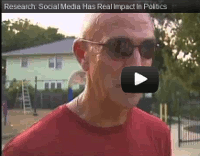
FOR THE WEEK OF SEP. 10, 2012
Social media analysis shows 'digital gap' between presidential rivals Romney and Obama

![]() Pick a lively or amusing comment under any politics story and tell whether you agree, disagree or are entertained.
Pick a lively or amusing comment under any politics story and tell whether you agree, disagree or are entertained.
![]() See if you spot coverage of any topic that has a tie-in with YouTube, Twitter or other social media.
See if you spot coverage of any topic that has a tie-in with YouTube, Twitter or other social media.
![]() Do you see social media ways to engage with the newspaper?
Do you see social media ways to engage with the newspaper?
One notable difference between Republican candidate Mitt Romney and President Obama involves their campaigns' social media skills, a recent study shows. Though each side uses digital tools to talk directly with voters, seek donations and rally volunteers, an independent research center found that Obama's team posted nearly four times as much content as Romney's campaign and was active on more platforms.
The president's online content also earned more responses -- twice the number of shares, views and comments, according to the Pew Center's Project for Excellence in Journalism, a neutral group in Washington, D.C., that did a detailed study during June and July of the national campaigns' websites and activity on Facebook, Twitter and YouTube. Separate research issued last week by a different Pew project shows that 36 percent of social network users say the sites are “very important” or “somewhat important” for keeping up with political news.
The main study, released in August, found that Obama's campaign published 614 pieces of content across the three platforms during a two-week study period and Romney's posted 168 items. The gap was the greatest on Twitter, where the Republican campaign averaged one daily tweet, versus 29 from Obama's re-election staff. Obama also produced about twice as many blog posts on his political website as did Romney and more than twice as many YouTube videos. Last week, the president's acceptance speech at the Democratic National Convention set a record for political moments on Twitter -- with 52,756 tweets per minute coming just after its conclusion Thursday night, the company announced. And according to the Nielsen rating service, the Democratic convention drew more viewers than the Republicans each night.
![]() Pew researcher says: "Historically, candidates who are first to exploit changing technology have an advantage." -- Tom Rosenstiel, director of the Project for Excellence in Journalism
Pew researcher says: "Historically, candidates who are first to exploit changing technology have an advantage." -- Tom Rosenstiel, director of the Project for Excellence in Journalism
![]() Columnist says: "It is too early to say what the Obama campaign’s digital edge will mean on Election Day, but if it can convert virtual engagement into actual turnout, that could turn a tough race into an easy one." -- Charles M. Blow, New York Times
Columnist says: "It is too early to say what the Obama campaign’s digital edge will mean on Election Day, but if it can convert virtual engagement into actual turnout, that could turn a tough race into an easy one." -- Charles M. Blow, New York Times
![]() Candidate websites: www.electmitt2012.org and www.barackobama.com
Candidate websites: www.electmitt2012.org and www.barackobama.com
Front Page Talking Points Archive
Common Core State Standard
SL.CCS.1/2/3/4 Grades 6-12: An essay of a current news event is provided for discussion to encourage participation, but also inspire the use of evidence to support logical claims using the main ideas of the article. Students must analyze background information provided about a current event within the news, draw out the main ideas and key details, and review different opinions on the issue. Then, students should present their own claims using facts and analysis for support.
©2024 Boston Herald in Education and Online Publications Inc. and NIEonline.com
![]()
![]()





